History intertwines as Kemites and Biblical figures cross paths, revealing a shared narrative that challenges and enriches our understanding of the past.
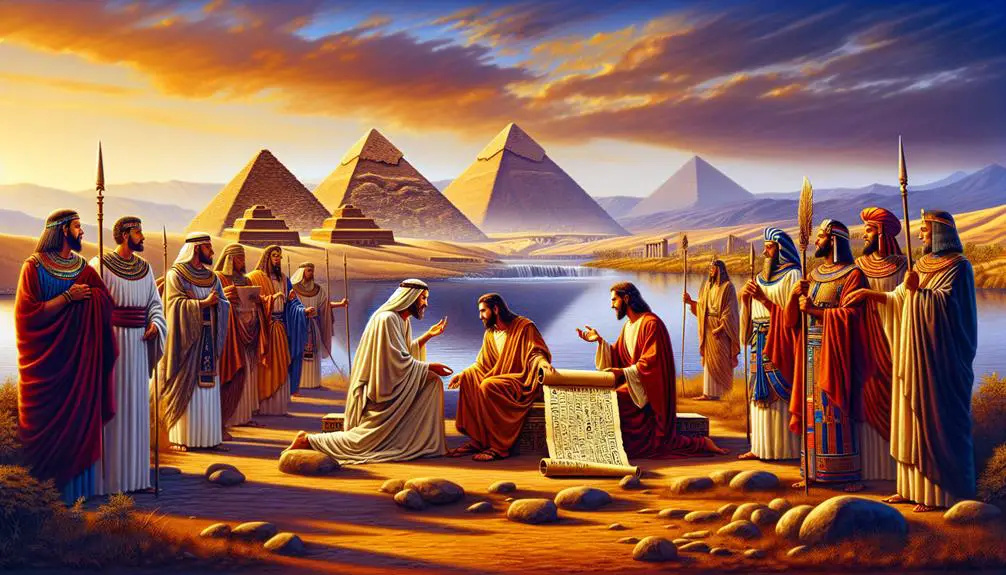
Kemites in the Bible
You might think that the Bible and Kemetic history stand worlds apart, but a closer look reveals a rich tapestry of interactions that have shaped religious narratives and cultural exchanges.
From Joseph's ascendancy in Egypt to Moses' upbringing in Pharaoh's court, the stories of Kemites and Biblical figures are intricately woven together, offering a unique perspective on ancient civilizations.
As we explore the pivotal moments of Exodus and the diplomatic exchanges between Solomon and the Queen of Sheba, you'll discover how these encounters have left an indelible mark on history, inviting you to reconsider what you thought you knew about these ancient worlds.
Key Takeaways
- Kemite deities and traditions influenced early monotheistic tendencies in the Hebrew Bible.
- Biblical figures like Joseph and Moses had significant interactions with Egypt, shaping their leadership and beliefs.
- Cultural and religious exchanges between Kemites, Nubians, and others enriched the religious landscape, including the integration of deities.
- The societal impact of plagues and crises in Egypt is reflected in biblical narratives, highlighting the challenges faced by Kemites.
The Genesis of Kemite Influence
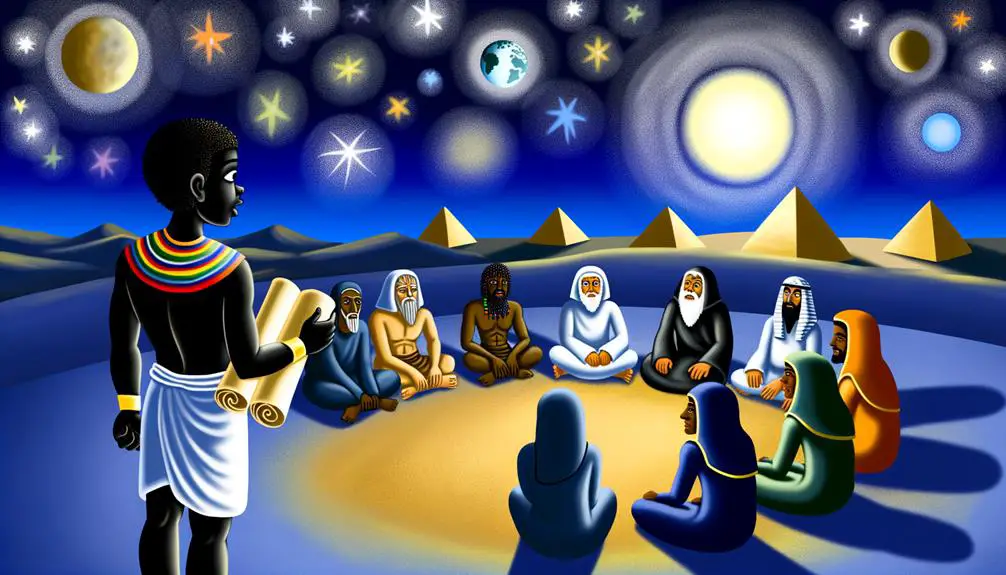
In tracing the origins of Kemite influence in the biblical narrative, one discovers that its roots extend deep into the fabric of ancient Near Eastern history, showcasing a profound interaction between the peoples of Kemet (ancient Egypt) and the Israelites. This interconnection isn't merely a backdrop for biblical events but a pivotal aspect that shaped the cultures, religions, and histories of both civilizations.
Kemite mythology, with its rich pantheon of gods and complex cosmologies, provided a fertile ground for cultural and religious exchange. The Israelites, during their formative years, were undeniably exposed to these narratives. Such exchanges weren't one-sided; they were a dynamic dialogue that enriched both traditions. The influence was so significant that traces of Kemite deities and their attributes can be subtly discerned within the Hebrew Bible, reflecting a syncretism that scholars are still unpacking today.
Furthermore, the geographical proximity of Ancient Nubia to Kemet added another layer to this intricate web of interactions. Nubia, rich in resources and culture, served as a bridge for the transmission of ideas, goods, and religious beliefs between Kemet and the emerging Israelite identity. This tripartite relationship between Kemet, Nubia, and the Israelites created a cultural and religious melting pot that influenced the development of early monotheistic tendencies among the Israelites.
The genesis of Kemite influence in the biblical narrative, therefore, isn't just a tale of two civilizations encountering each other but a complex story of cultural synthesis, religious exchange, and mutual enrichment that laid the groundwork for significant portions of the biblical tradition.
Joseph's Sojourn in Egypt
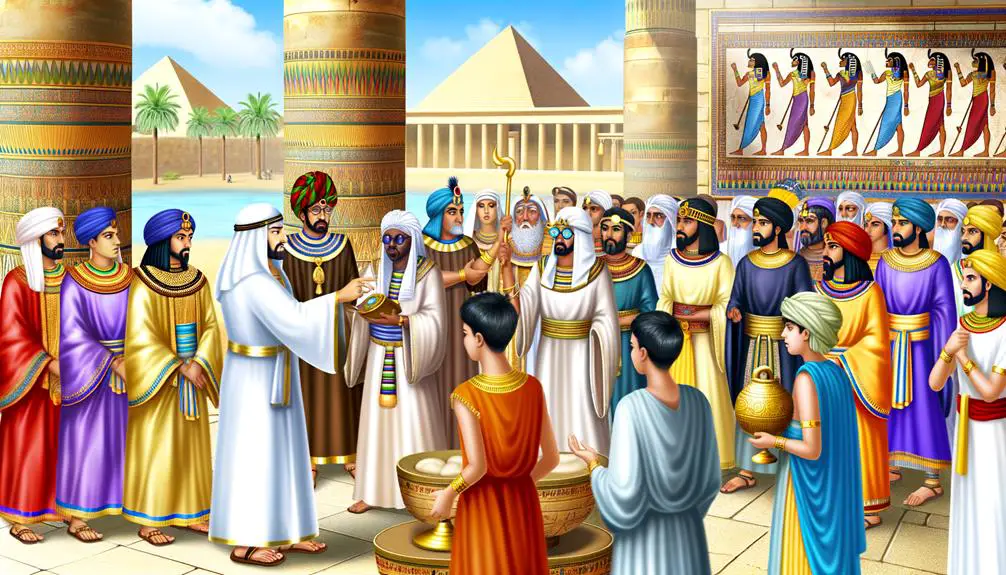
Often overlooked, Joseph's sojourn in Egypt marks a critical juncture in the biblical narrative, where personal destiny intertwines with the broader currents of cultural and historical exchange. This period in Joseph's life, initiated by his brothers' betrayal, sets the stage for a profound exploration of identity, power, and divine providence within a Kemite context.
Joseph's dreams, vivid predictions of his future ascendancy over his family, ignite the envy and malice of his brothers, leading to his sale into slavery. This act of betrayal, however, paradoxically propels Joseph into a position where his abilities can flourish. In Egypt, Joseph's interpretive prowess with dreams catches the eye of Pharaoh, pivoting him from a prisoner to a prime minister. His journey from Canaanite shepherd to Egyptian official exemplifies the complex interplay of faith, fate, and fortitude.
The narrative underscores the impact of cultural assimilation and exchange. Joseph, though a Hebrew, adopts Egyptian practices and language, even marrying within the Egyptian elite. This fusion of identities highlights the permeability of cultural boundaries and the potential for individuals to bridge disparate worlds.
Moreover, Joseph's governance during the famine not only saves Egypt but also his own family, setting the stage for the Israelites' prolonged stay in Egypt. This period of cohabitation fosters a symbiotic relationship, where Hebrews and Egyptians influence each other's religious, social, and political landscapes.
Joseph's sojourn in Egypt, therefore, isn't merely a tale of personal triumph but a testament to the enduring legacy of cross-cultural interactions, shaping the destinies of nations and the course of biblical history.
Moses: From Prince to Prophet
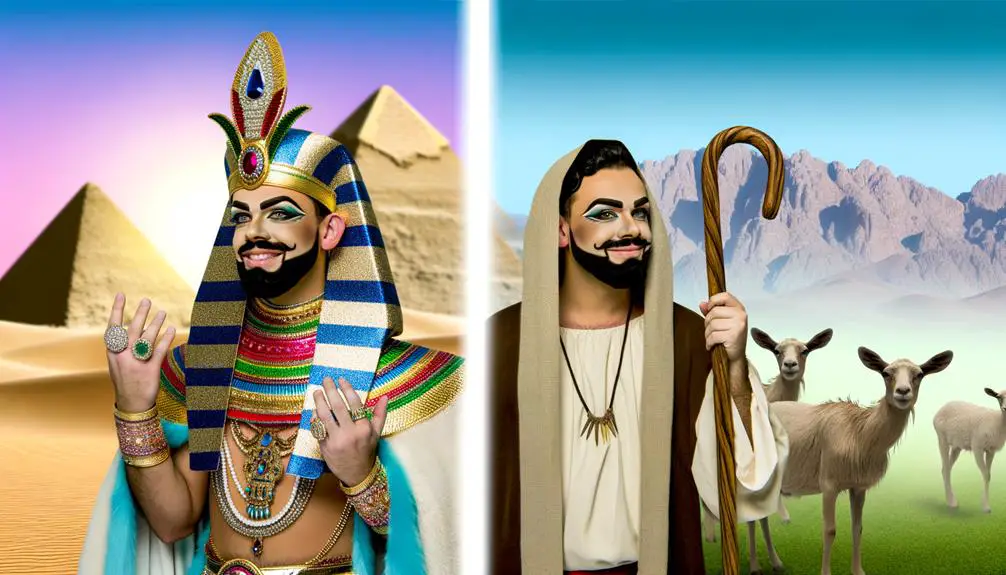
You'll find Moses's journey from prince to prophet intriguing, especially considering his Egyptian royalty education and subsequent leadership transformation during the Exodus.
His upbringing within Pharaoh's palace provided him with unique insights and skills, crucial for his later role in leading the Israelites out of Egypt.
This transition underscores a profound shift in identity and purpose, highlighting the interplay between his early life among the Kemites and his destiny as a prophet.
Egyptian Royalty Education
Delving into the narrative of Moses, his education as Egyptian royalty not only equipped him with unparalleled leadership skills but also laid the foundation for his transformation into a prophet. Central to this education were:
- Hieroglyphic curriculum: Mastery of this complex writing system was essential for communication and governance.
- Architectural studies: Knowledge of construction and design principles, reflecting Egypt's advanced civilization.
- Diplomatic training: Skills in negotiation and foreign relations.
- Religious instruction: Understanding of Egyptian deities and rituals, offering insights into spiritual leadership.
Such a comprehensive education underscored Moses's unique position, bridging cultures and epochs. It's this blend of secular and sacred knowledge that notably prepared him for his eventual role beyond Egyptian royalty, without delving into his later leadership transformation during the Exodus.
Exodus Leadership Transformation
Transitioning from prince to prophet, Moses's leadership evolution during the Exodus exemplifies a dramatic shift in his role and responsibilities. Initially, Moses's upbringing within Egyptian royalty provided him a unique perspective and set of skills, which, although valuable, needed significant adaptation for his subsequent responsibilities.
Amidst desert wanderings, Moses not only guided the Israelites physically but also spiritually, facilitating covenant formation between them and the divine. This transformation from a secular leader to a spiritual guide underscores a profound change in leadership dynamics.
Analyzing this transition reveals the complexities of Moses's character, illustrating how his experiences as a prince were both an asset and a challenge in his prophetical role, especially in navigating the intricate process of covenant formation and leading a people through the uncertainty of desert wanderings.
The Exodus: A Pivotal Departure
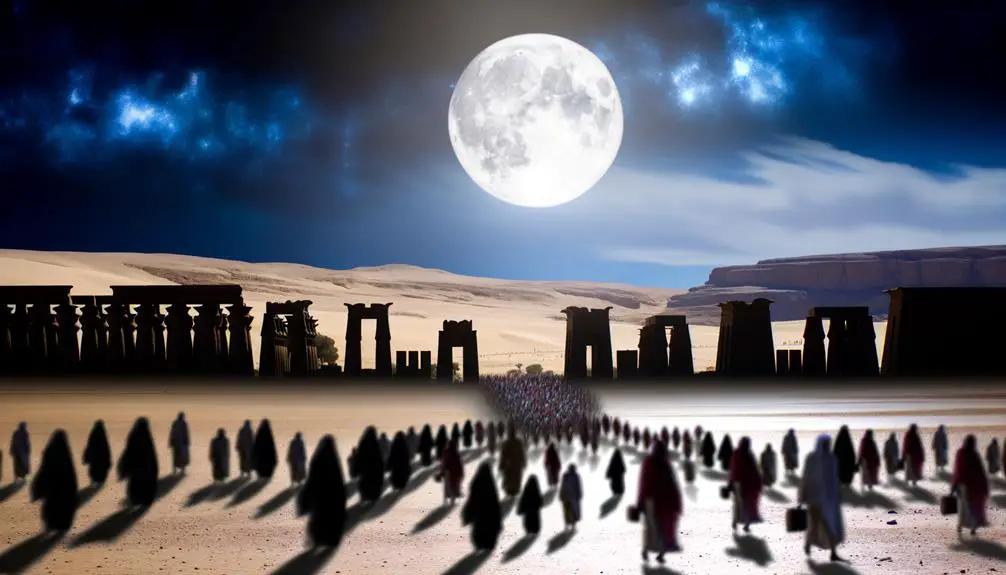
You'll find the story of the Exodus marks a significant transition in the relationship between the Israelites and the Egyptians, underscored by the plague narratives. These events not only highlight the calamities that befell Egypt but also underscore Moses' critical leadership role in guiding the Israelites towards freedom.
This departure isn't merely a physical journey but also a transformational moment in biblical history, reflecting on themes of liberation, faith, and divine intervention.
Egypt's Plague Narratives
The narrative of the plagues in Egypt, as recounted in the Exodus story, marks a critical juncture in the history of the Kemites, showcasing divine intervention and the eventual liberation of the Israelites. This sequence of calamities not only signifies the power struggle between Pharaoh and Moses but also highlights the profound impact on Nile ecology and locust science.
- Disruption of Nile Ecology: The transformation of water into blood severely affected the river's ecosystem.
- Agricultural Devastation: Locusts, as explained by locust science, decimated crops, showcasing their destructive power.
- Economic Impact: The loss of crops and livestock crippled Egypt's economy.
- Societal Strain: These events caused widespread suffering, highlighting the social and psychological distress experienced by the Kemites.
Moses' Leadership Role
Amidst the backdrop of Egypt's plagues, Moses emerged as a pivotal leader, guiding the Israelites through their liberating exodus with strategic acumen and unwavering faith. His leadership wasn't solitary; Aaron's role was instrumental, serving as his spokesperson and collaborator in presenting the case for liberation to Pharaoh. This partnership was crucial in navigating the political and spiritual challenges they faced.
The exodus itself was marked by miraculous events, underscoring Moses' unique relationship with the divine. These wonders not only facilitated their escape but also solidified Moses' authority among the Israelites. His ability to intercede with God, perform signs, and lead despite adversity showcases a leadership model that blends spiritual conviction with practical governance, setting a foundational example for future generations.
Solomon and the Queen of Sheba
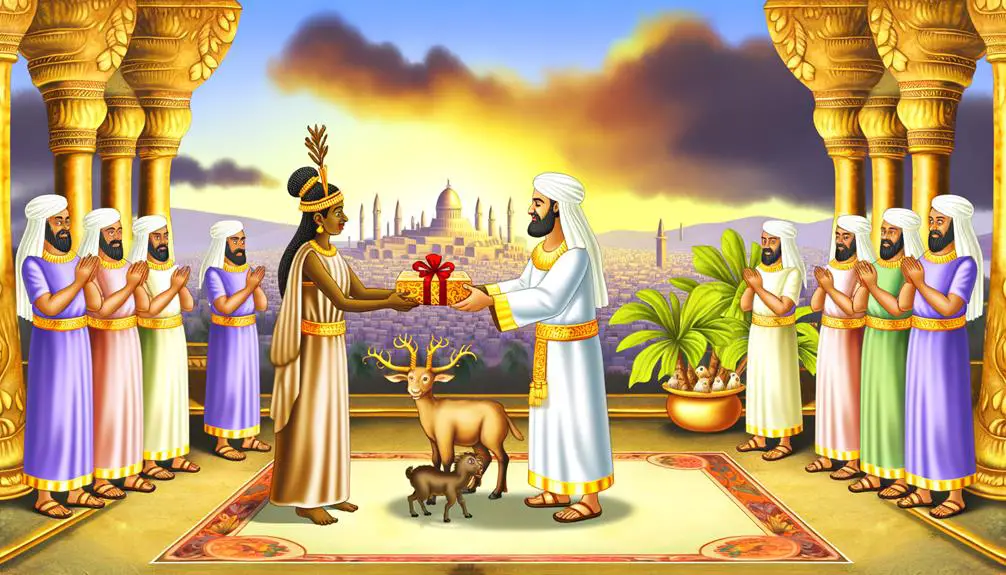
Why does the story of Solomon and the Queen of Sheba captivate scholars and historians alike? At its core, this narrative weaves together the grandeur of ancient kingdoms, the allure of wisdom, and the intrigue of diplomatic relationships. It's a tale that highlights the significance of trade expeditions and architectural influences between the Kingdom of Israel and the Kingdom of Sheba, underscoring the interconnectedness of ancient civilizations.
The account of Solomon and the Queen of Sheba isn't just a story of personal interaction; it's a reflection of the rich cultural exchanges that shaped the ancient Near East. Here are four key aspects that scholars emphasize:
- Trade Expeditions: The narrative underscores the importance of trade routes that connected the Kingdom of Israel with the Kingdom of Sheba, facilitating the exchange of goods, ideas, and technologies.
- Architectural Influences: The visit of the Queen of Sheba to Solomon's kingdom likely led to architectural innovations, as each kingdom gained insights into the other's building techniques and styles.
- Diplomatic Relations: Their meeting symbolizes the diplomatic efforts to strengthen ties between two powerful kingdoms, showcasing the role of diplomacy in ancient geopolitics.
- Cultural Exchange: Beyond trade and politics, the story hints at a deeper level of cultural interchange, including the sharing of knowledge, religious beliefs, and artistic expressions.
Analyzing the interaction between Solomon and the Queen of Sheba offers insights into how ancient civilizations thrived through cooperation and mutual respect. It's a testament to the complexity of human relationships and the enduring fascination with historical narratives that connect us to our past.
Cultural and Religious Intersections
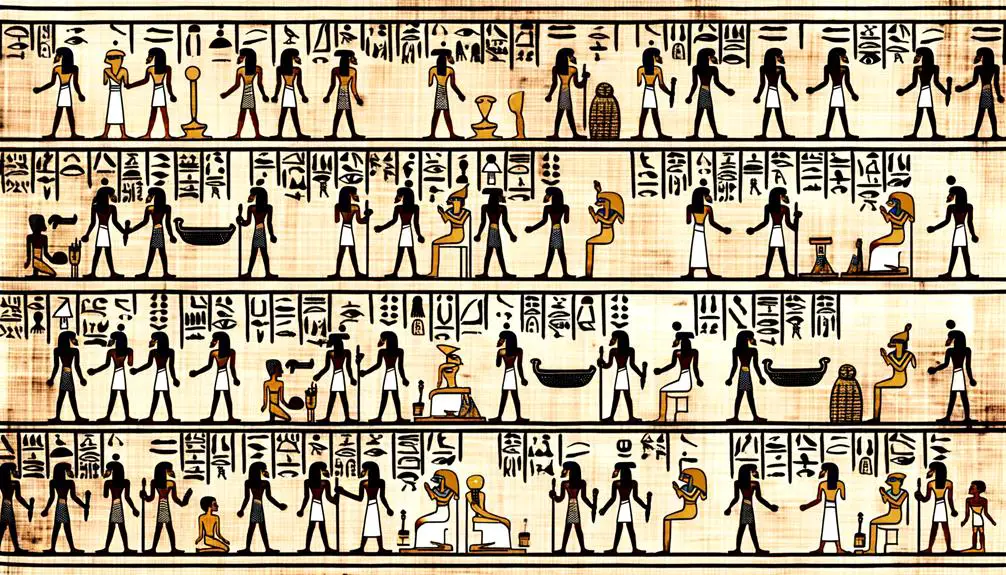
Exploring the cultural and religious intersections between ancient civilizations reveals a complex tapestry of beliefs and practices that shaped their identities and interactions. You'll find that the historical narratives of the Kemites—ancient Egyptians—are rich with instances of cultural and religious exchanges, particularly evident in their interactions with neighboring civilizations, such as the Nubians and Assyrians.
Delving into the Nubian parallels, you discover that the cultural and religious ties between Nubia and ancient Egypt were deeply intertwined. The Kemites shared gods, religious rituals, and funerary practices with the Nubians, indicating a profound spiritual and cultural exchange. This interconnectedness wasn't merely superficial; it was foundational to their identities, with Nubian deities and beliefs being integrated into the Kemetic pantheon, reflecting a mutual respect and acknowledgment of their shared religious heritage.
Turning your attention to Assyrian contacts, the relationship takes on a different dimension. The Assyrians, known for their military prowess, came into contact with the Kemites through conquest and diplomacy. Despite the underlying tension, these interactions led to exchanges in religious thought, technology, and governance. Assyrian gods were introduced into the Kemite religious landscape, and vice versa, signifying a begrudging respect and the inevitable blending of cultures that occurs when empires collide.
In analyzing these intersections, you grasp the complexity of ancient religious and cultural exchanges. They weren't monolithic entities but were instead dynamic, evolving in response to internal developments and external contacts. Through the lens of Nubian parallels and Assyrian contacts, the nuanced story of ancient Kemite civilization's religious and cultural landscape unfolds, offering insights into the ancient world's interconnectedness.
Frequently Asked Questions
How Have Modern Archaeological Findings and Historical Research Altered Our Understanding of the Kemites' Role in Biblical Narratives?
Recent archaeological findings and historical research have significantly changed your understanding of ancient civilizations' roles in historical narratives. Through the decipherment of ancient scripts and cultural artifact analysis, scholars have shed new light on these societies' contributions and interactions.
This analytical approach has allowed you to see beyond traditional narratives, revealing a more nuanced view of history that emphasizes the complexity and interconnectedness of ancient cultures, including their roles in shaping historical events and stories.
In What Ways Have the Interpretations of Kemite Characters in the Bible Evolved Within Various Religious Communities Over Time?
You're examining how interpretations of certain characters have shifted within religious realms. Initially, cultural misinterpretations and religious appropriation skewed perceptions, painting them in a monolithic manner.
Recently, scholarly scrutiny has sparked a shift towards more nuanced views, recognizing their diverse roles and contributions. This evolution reflects a growing appreciation for historical complexities, moving beyond simplistic narratives to embrace a broader, more accurate understanding of their significance in religious texts.
Are There Any Lesser-Known Kemite Figures Mentioned in the Bible Whose Stories Have Been Overshadowed by More Prominent Narratives?
Yes, there are several lesser-known figures with roots in Kemite mythology mentioned in the Bible, often overshadowed by more prominent narratives. These characters, while not always front and center, play crucial roles that underscore the rich tapestry of Biblical parallels with Kemite stories.
Analyzing these figures reveals a nuanced layer of cultural exchange and influence, enriching our understanding of the text's historical and mythological context.
How Do Contemporary Kemite Scholars and Communities View Their Representation and Portrayal in the Biblical Context?
You're navigating a complex landscape where modern Kemite scholars and communities often find their cultural identity and history intertwined with biblical portrayals. Through a lens sharpened by genetic studies, they critically analyze their representation, seeking accuracy and respect.
This scholarly journey isn't just about correcting misconceptions; it's about reaffirming a rich heritage that transcends ancient texts. Their quest blends rigorous academic scrutiny with a deep connection to their ancestral roots.
What Is the Significance of Kemite Language and Symbolism in the Understanding of Biblical Texts, and How Has It Influenced Biblical Scholarship?
You're exploring how ancient languages and symbols shape our understanding of sacred texts. Kemite Cosmology and Symbolic Hieroglyphs play a pivotal role, offering deep insights into biblical narratives.
These elements don't just add historical context; they transform biblical scholarship by unveiling layers of meaning previously obscured.
Your grasp of these symbols and their cosmology directly influences how you interpret biblical texts, uncovering connections and interpretations that might've been overlooked.
Conclusion
As you've journeyed through the tapestry of biblical narratives, it's clear the threads of Kemite influence are intricately woven into its fabric. From Joseph's sojourn, Moses' transformation, to Solomon's alliance with Sheba, these intersections shimmer like stars in a shared sky, highlighting a rich, cultural confluence.
This exploration isn't merely about historical encounters; it's a testament to the profound, enduring interplay between civilizations, illuminating our understanding of ancient texts and the complex web of human interconnectedness.



Sign up